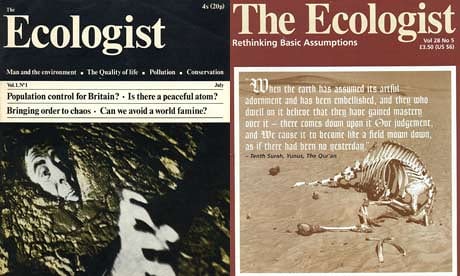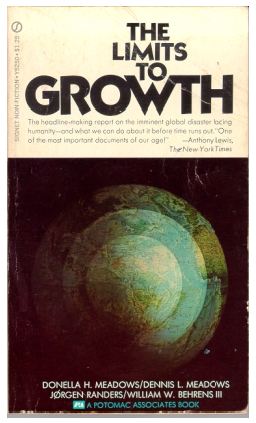|
|
| home | exhibitions | interviews | features | profiles | webprojects | archive |
|
Origins : The Ecologist and Blueprint for SurvivalDavid Taylor describes the early history of the pioneering Ecologist magazine which, for over a decade, was edited in Cornwall UK.
The founders of 'The Ecologist' magazine met “at meetings called by Nicholas Guppy, Robin Hanbury-Tenison and Francis Huxley which led to the formation of the Primitive Peoples’ Fund, now Survival International.” Hanbury-Tenison is still involved and is Survival International’s current president.As Robert Allen, one of the magazine’s founders, continues: “Teddy (Goldsmith), Peter (Bunyard) and I were among a minority of participants in the meetings (others were Jean Liedloff and Conrad Gorinsky) who felt that the survival of tribal minorities was closely tied to the environmental crisis and that both issues should be addressed together.Teddy and I often discussed how we could raise awareness of the environment and of the complex of related issues...Eventually we settled on a monthly magazine, the Ecologist. Teddy and I were involved virtually full-time; the other originating dramatis personae (Peter Bunyard, Michael Allaby, Jean Liedloff), part-time.”
Michael Allaby worked alongside him in the editorial department of the Soil Assoc -iation from 1964-1972. Allaby remembers: “Whilst there, probably early 1970, I received a telephone call from someone introducing himself as Teddy Goldsmith and inviting me to lunch at the Ritz. So I went - who wouldn’t? There I met Teddy in the company of Jean Leidloff. Teddy told me about the magazine he was preparing to launch and asked me to write for it, I agreed. For a while that was how it worked. I was simply a contributor.”“Then the Ecologist ran into production difficulties. We at the Soil Association had spare capacity and so the Association contracted to produce the magazine. That’s how it worked, with regular meetings in Suffolk and with me and my assistant producing the magazine and me dealing with the printers (in Leicester). During this time I came to know Robert (Allen) who was deputy editor.”“When it was decided to publish a daily newspaper during the Stockholm Conference I was much involved in setting it up and working on it for part of the conference. After Stockholm the editorial team decided they should devote more time to the magazine and that we should establish a permanent office (rather than Teddy’s home in Kew). Robert was most involved in this and his friend Hanbury-Tenison persuaded us to move to Wadebridge in Cornwall and base the Ecologist there.”And so it was that this early formative group of eco-pioneers - Teddy Goldsmith (editor), Robert Allen (deputy editor), Michael Allaby (managing editor), Peter Bunyard and Robin Hanbury-Tenison - all found themselves in Cornwall in October 1972, soon after publishing the 'Blueprint for Survival' and launching the 'Movement for Survival' (forerunner of the UK Green Party). Although he visited, Robert Waller did not join the exodus to Cornwall. Allen: “Teddy always accused me of leading the exodus, responding to the blandishments of Robin Hanbury-Tenison. (I was also the first to leave Cornwall).” Goldsmith’s friend, Jeremy Faull did the conveyancing and later moved to Cornwall as well. Although he never had any direct involvement in the magazine he did become the Ecology Party’s first-ever county councillor in 1977, representing the Withiel division near Bodmin in Cornwall. It was within this circle that many of the core Green political ideas - of sustainability, the stable society and a steady state economy- were incubated. 'Blueprint for Survival' was described, by its authors, as a programme and can be thought of as the world’s first eco-manifesto. It was used in place of an official manifesto, by PEOPLE (which merged with 'Movement for Survival') during the first 1974 UK general election, and served as primary source material for early green party manifestos elsewhere as well.
“The idea of 'Blueprint for Survival' may have been mine but it was not because we were short of material for the January issue (of the Ecologist). Blueprint was in the works for many months, as Teddy wrote and rewrote several drafts of what became the appendices—and then, once that was done, I wrote and revised the first two chapters. Then we needed time to gather the signatories and plan the launch. Obviously not something done on the spur of the moment to fill a gap." Robert and Teddy had contact with the authors of 'Limits to Growth' during the time they were drafting Blueprint. Allaby: “Teddy had obtained a copy of the draft of Limits to Growth long before it was published. The idea of Blueprint was Robert’s." Allen: “[Blueprint] was not based on the ideas in 'Limits to Growth'. As you can see from the citations, we drew on many sources for inspiration and information, of which 'Limits to Growth' was one and by no means the most important. The list of citations is a fair reflection of our direct sources but underlying these was a foundation of a vast amount of thought that Teddy had been bringing together in the course of his work (which began before the founding of the Ecologist) on the many iterations of the book he eventually published as 'The Way'." “I wrote the first two chapters of Blueprint for Survival: ‘Introduction: the need for change’ and ‘Towards the stable society: Strategy for change’. Teddy wrote the third chapter ‘The Goal’ and the appendices. Peter and other co-authors helped throughout.” 'Blueprint for Survival' become a best-seller, selling 750,000 copies worldwide, being debated in the House of Commons and serving as inspiration for many Green manifestoes, including 'Blueprint for New Zealand' in May 1972 and, in the UK, PEOPLE’s 'Manifesto for Survival' in June 1974. Allen: “We knew it was groundbreaking. But we did not expect it to have such an impact, although we carefully planned its release to make sure it could. I was part of the Environmental Communicators Organisation (ECO), an informal group of environmental journalists and writers (others were Alan Massam of the Evening Standard and Graham Leach of the Observer). They were the ones who suggested we assemble an impressive group of eminent signatories and told us when to hold the press conference (the day and the time) and what to prepare for it. Then John Maddox, editor of Nature, unwittingly catapulted us into high media visibility by attacking us in a lead editorial. We had great fun debating him on TV. Thank you John.”
David Taylor is a life-long environmental activist and co-founder of www.green-history.uk, where this article - based on email exchanges by the author - was originally published. See also http://www.green-history.uk/articles/general/origins-mfs, and artcornwall's interview with editor Peter Bunyard. 26/12/17 |
|
|

 Robert
Waller was an associate editor of the Ecologist and a former editor
(1964 to 1970) of the Soil Association journal. He published his own
polemical attack on industrial society,
Robert
Waller was an associate editor of the Ecologist and a former editor
(1964 to 1970) of the Soil Association journal. He published his own
polemical attack on industrial society,  Some
have suggested that
Some
have suggested that